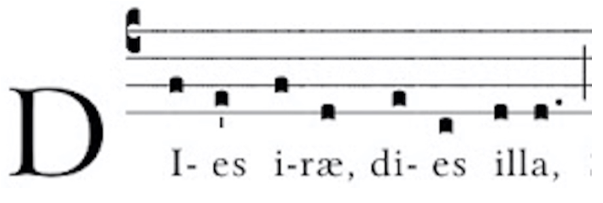In preparing for our Advent theme, In Light & Darkness, I’ve been spending a lot of time considering the ways in which many of us often perceive our lived experience in terms of dualities. As far back as opening words to Genesis 1, people of our Judeo-Christian faith have been concerned with the separateness of important dualities that seem to define our reality – void and existence, light and darkness, water and land. And, of course, one could argue that understanding the duality between life and death is the primary concern and struggle of the New Testament. But these perceived dualities are ultimately unified in their necessarily symbiotic relationships – one aspect of them can’t be known without the other.
Throughout 2020, we’ve experienced collective loss, pain, and death beyond anything any of us could ever have imagined. It seemed fitting that, as we close the calendar year, we pay our respects to those lives lost with a musical theme based on the Dies irae, a Latin hymn that has been used for centuries as a sung prayer for the dead.

Throughout the years, composers have used this melody (as well as the first four notes of it) to symbolize death and despair. Upon listening to the “Dies Irae” episode of the Twenty Thousand Hertz podcast, you may be surprised to find how strongly this melody has planted itself in your own mind as a harbinger of doom.
Our new congregational song for the season of Advent, “In Light & Darkness,” begins with this “Dies Irae” figure in a minor key as the melodic theme of the verse while the lyrics suggest perceived dualities that are in tension with each other (and include the classic Advent themes of hope, peace, joy, and love). During the pre-chorus, however, the melody rises to symbolize an overcoming of these dualities in a greater reality. The lyrics speak to our perseverance as a community through what seems like darkness all around us as we prepare our hearts for the birth of Christ – through a kenotic death to self. The melody of the chorus inverts the “Dies Irae” melody (turns it upside down) and stretches out the interval, leading to a major key and symbolizing what Jesus will bring – an overcoming of death! The lyrics encourage us not to fight against the darkness, but to trust in God by letting our “eyes adjust” so that we might better see the light that eternally shines, even in the darkest spaces. It is in this light that we find the love of Christ, which always leads us home.
We will use this song in worship throughout Advent, so I hope you will be inspired to view the lyric video in order to learn the song and sing along. We remember that darkness is necessary for us to know the light, which continues to shine within and throughout the farthest reaches of the universe. Even after all that we’ve been through this year, we know that Christ is still coming!
Christian McIvor
Minister of Worship, Music and the Arts
Resources Used for this Article:
Gregorian Chant Hymns, “Dies Irae.”
Twenty Thousand Hertz Podcast, Episode 107, “Dies Irae.”
“In Light & Darkness” Lyrics: Wait and hurry Hope and worry Song and silence Peace and violence Through the loss and pain, we won’t give in – Let the Christ be born within! Living in light and darkness In you, we keep our trust, we’ll let our eyes adjust; Living in light and darkness Death will be overcome because your love Lights our way, leading us home… You’re leading us home.. Past, tomorrow Joy and sorrow Void, existence Love, indifference Change our hearts as we begin again – Let the Christ be born within! Living in light and darkness In you, we keep our trust, we’ll let our eyes adjust; Living in light and darkness Death will be overcome because your love Lights our way, leading us home… You’re leading us home.. Grace is here no matter where we’ve been – Let the Christ be born within! Living in light and darkness In you, we keep our trust, we’ll let our eyes adjust; Living in light and darkness Death will be overcome because your love Lights our way, leading us home… You’re leading us home.. ©Christian McIvor, 2020